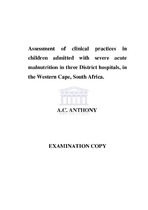| dc.description.abstract | Background: Severe acute malnutrition contributes disproportionately to child mortality rates despite availability of the WHO protocol, “Ten Steps”, to guide hospital management. Auditing morbidity and mortality rates of malnourished children at hospitals is useful to measure the effectiveness of hospital-based management compared to standards advocated by the WHO protocol. The study aimed to assess the adequacy of clinical management practices for severely malnourished children admitted to three district hospitals in the Western Cape as compared to the WHO guidelines.
Objectives: To describe prognostic indicators on admission such as clinical
severity of malnutrition and co-morbidities such as HIV, TB, diarrhoea and
pneumonia. To assess the management practices of severe malnutrition against the key principles of management during the stabilisation phase as outlined by the WHO guidelines. To describe the number of severely malnourished children who were treated for or died due to preventable complications (hypothermia, hypoglycaemia, dehydration, over-hydration, infection, electrolyte imbalance). Methodology: A retrospective, descriptive study based on a folder review of medical records of 83 severely malnourished children admitted to the Stellenbosch, Helderberg and Eersteriver hospitals from September 2009 to June 2011 was done.
viii Structured data collection was undertaken to capture data to allow assessment of the clinician’s management practices, and the adequacy thereof in implementing the first six steps of the WHO protocol guidelines.
Results The predominant co-morbidities in the sample were diarrhoea in 51% ofcases and pneumonia in 33%. Thirteen percent were HIV infected, 28% of the sample had TB. Clinical signs were poorly documented by clinicians. The highest percentage of adequate management practices was for treatment of infections with 90% of patients receiving antibiotics. The second best management practice was for treatment of electrolyte and micronutrient deficiency. Hypoglycaemia and hypothermia were poorly managed as children developed these complications in the hospitals and yet these complications were still left untreated. Nineteen percent of the sample needed transfer to a specialist hospital. Conclusion The study concludes that overall management practices for children admitted with severe acute malnutrition to three district hospitals in the Western
Cape was poor and often did not adhere to the WHO guidelines. Doctors showed poor understanding of the need for accurate assessment and monitoring in order to reduce the mortality risk of these patients. | en_US |

